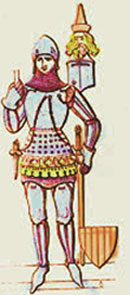Medieval Armor
The Medieval armor is starting to show a more rapid evolution only towards the end of the first millenium. Under the reign of Charlemagne, the protection of warrior's body was still a mixture of Roman and Northern elements. For this reason, we look only at the development of the Middle Ages armor between the Norman period and the 15th century.
The Medieval Armor can be studied either by century, as this page does, or considering other criteria as follows:
Medieval Armor Types
Medieval Armor Parts
Medieval Troops Armor
Medieval Norman Armor
In the early Norman times, the Medieval armor was mainly the chain mail armor, quilted-work, jazerant, scale, and a small proportion of plate used as an additional protection to the breast. The scale was a type of armor made of small metallic scales overlapping, and fastened upon leather or cloth, while the jazerant was a body defense made of small plates of metal sewn upon linen. The materials were iron, leather, and horn, with wool, tow, or cotton for quilting defenses.
Hauberk Armor
12th Century
The Bayeux Tapestry is one of the most valuable sources in establishing what was the standard Medieval armor of the period. The components of the body armor worn by the knight were the tunic, the gambeson and the hauberk. The gambeson was a defensive garment made of stuffed and quilted cloth. The surcoat, though found in same rare instances at the close of the 12th century, does not become a characteristic part of the knight armor till the 13th century.
The hauberk was the chief part of the Medieval suit of armor of the period. It reached to the knees. The skirt sometimes opened in front, sometimes at the sides. The sleeves usually terminated at the elbow, but occasionally extended to the wrist. The hauberk could reach as high as the neck only, but more generally it was continued so as to form a coif, leaving only the face of the knight exposed. The above picture depicts a hauberk with lateral openings. It is remarkable also for the way the sword is carried partially beneath the hauberk. The defense is continued over the head as a coif. This feature of the suit of armor of the period is also known as the "continuous coif" and is surmounted by the usual conical nasal helmet.

Suit of Armor (Hauberk)
With Flattened Coif
At the beginning of the 13th century, the hauberk of chain mail was made with continuous coif and gloves. The coif was flattened at the top of the head, and the gloves were not divided into fingers. The hauberk descended nearly to the knees. To protect the face of the knight on the battlefield, the opening left little more than the eyes and nose in view. In the same period, some armor models had the hood of mail made separately from the hauberk. In the second half of the century, the round topped coif became more usual. The sleeve of the hauberk was sometimes secured at the wrist by a lace or strap. In order to liberate the hands occasionally from their fingerless gloves, an aperture was left in the centre of the palm.
Medieval Transitional Armor: chain mail and plate
The medieval knights soon became dissatisfied with their old panoply of chain mail armor, and searched for substitutes. In the end they opted for a combination of the newer elements of plate with the old chain mail.
As a result, in the 14th century the knights' armor offers the most brilliant and striking combinations encountered during the Middle Ages. The armor, a mixture of chain mail, glittering plate, embossed leather, and rich heralding decorations, was an ample field for the display of color, and variety of form.
The Medieval suit of armor had as the main part the breast plate, continued under the waist with chain-mail, or metal strips covered with cloth or velvet. It is the time when the surcoat changed considerably. The long, old-fashioned surcoat proved to be a serious impediment on the battlefield, when the knights descended from their horses to fight on foot. To alleviate the problem, the garment underwent a clipping in front, still in this case the evil was but half remedied. As the full skirt was a necessity of long dress, now it had no purpose and could be abandoned, the result being the short, tight surcoat.
In the early years of this period, the legs armor consisted of the chain-mail chausses. As an occasional occurrence, we find them until the middle of the century. The legs defense, like the arms defense, made a steady progress to the complete equipment of plate.
Generally, the Medieval horse armor, named also "barding" followed the same patterns as its human counterpart.
In the second half of the 14th century, a new fashion emerged, the so-called camail armor. The camail was attached to the helmet and did not join the hauberk as before.
Medieval Plate Armor

Plate Suit of Armor
During the 15th Century, the Medieval armor was entirely made of plate. It had shoulder and elbow guards, and gauntlets formed of broad overlapping plates. The breast plate of the Medieval armor evolved from one piece to the two parts construction, lower overlapping the upper, and contrived, by means of straps or sliding rivet, to offer more flexibility.
Due to the metal friction, the knight could not wear ordinary clothes under the armor, no matter how skilled the armourer was. A very strong fabric was required. This material is mentioned in contemporary records as "Fustian". It is hard to say if it resembled the more modern fabric with the same name, but we can approximate and say that a material as either the 'Fustian" or the corduroy will conveniently prevent the friction of the Medieval armor metal.
